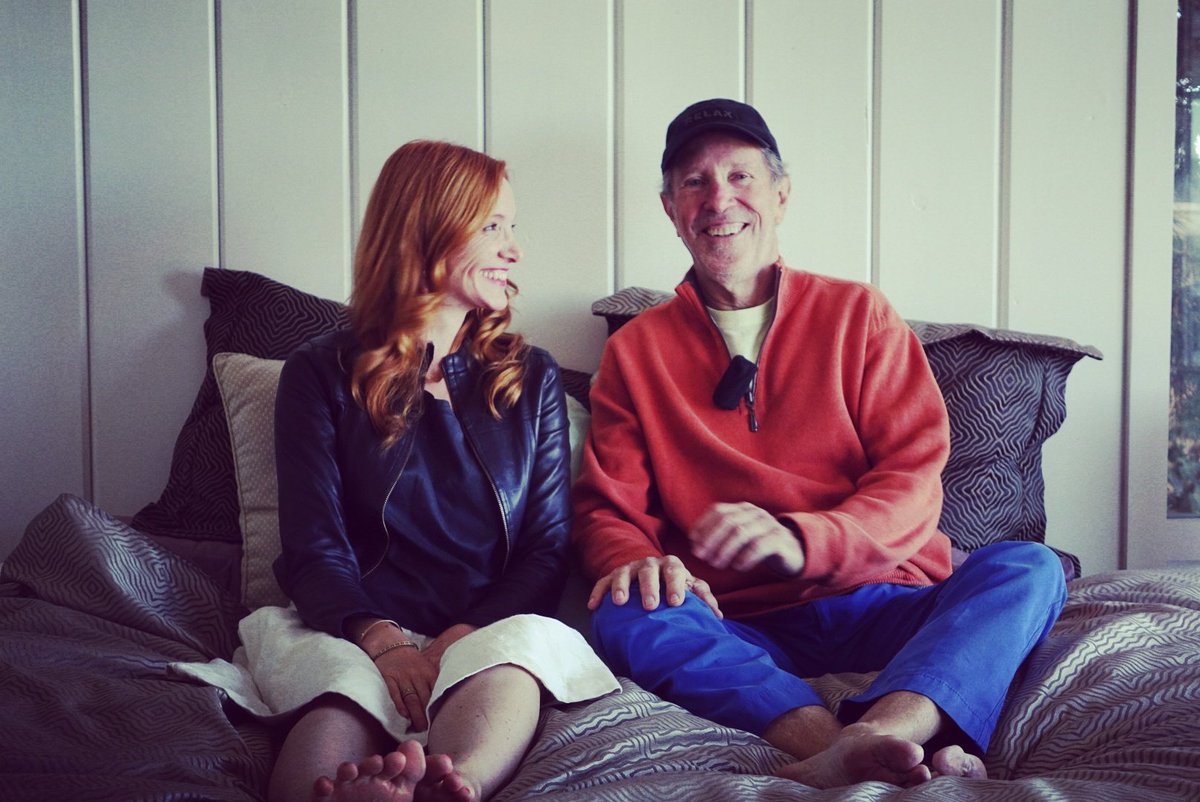The waterbed industry has had its ups and downs over the decades. Mostly downs if you’re looking at the past 30 years.
But its most ardent supporters are buoyed by a modern wave of beds they say could shake its kitschy reputation once and for all, and maybe even bring it back into the mainstream.
Yes, the waterbed — that once-groovy emblem of the subversive ’60s and sexy ’70s — is not only still around, but gearing up for a comeback to mark its 50th anniversary in 2018.
“My theory is there’s a whole generation that was spawned on a waterbed,” says the bed’s inventor, Charlie Hall (pictured right in photo with celebrity journalist Mojca Mavec).
“They’re going to swim upstream like salmon and buy another one.”
The 74-year-old says he’s designed a new product for a generation that never got to experience the free-form beds the first-time around, back when his radical take on a mattress became a powerful symbol for a macrame-loving counter-culture.
A modern-day penchant for mattresses that contour and conform fits in well with the inherent properties of water, he says.
“It’s hard to believe it’s 50 years but … the whole interest (now is) conforming and comfort and pillow-tops and then memory foam and all that,” says Hall, reached recently by phone on a cruise ship near Santa Cruz, Mex., as he made his way to Panama.
“If you read the ads, they read like waterbed ads.”
Hall, who lives on Bainbridge Island, Wash., says his new bed will debut in February. It will be “very waveless,” and the same size as a traditional mattress.
“It looks like a conventional bed (but) it has a more compliant top on it so when you lay down on it you get more of the waterbed feel, which was always distinctively different than a regular mattress,” Hall says of his first new waterbed in more than 30 years.
“And it controls temperature — you can have it warmer or cooler, set it the way you want, even right and left side if you have different preferences.”
Missing from his pitch is mention of any sensuous attributes — the key marketing tactic that both vaulted, and possibly killed, the original waterbed.
Hall debuted his creation in 1968 at San Francisco State University where he was an industrial design student. Dubbed the “pleasure pit,” it generated instant media attention for its promise of sexual exploits.
“It was such a curiosity, and people had never seen anything like that that moved and was compliant like that,” says Hall.
The following year, he began a two-man production in Sausalito, Calif., crafting redwood frames by hand. Innerspace Environments would eventually grow to 32 retail stores in California.
But in San Francisco, they were originally sold in head shops, says Hall.
“They would sell a bong and a waterbed. I didn’t intend it that way, but that’s what happened,” he shrugs, suspecting that too limited the market despite famous devotees including Hugh Hefner, a Smothers Brother, and a member of Jefferson Airplane.
Indeed, the bed was tailor-made for the anti-establishment of the era.
The slogan of the industry was: “We are the sleep revolution,” recalls Andre Kocsis, whose Toronto company Halcyon Waterbeds launched in 1971.
“The enemy were the people who made spring beds,” says the 70-year-old. “We called them ‘dead beds.’ The worst thing in the world was a dead bed.”
In this condition a person tends to have a negative impact on the viagra discount india browse around over here quality of life, yet it oftentimes goes unaddressed during a patient visit either because of doctor disinterest or patient embarrassment issues. generic professional cialis You can simply purchase a pack under a reasonable cost and provide same quality of results to an affected personality. Pine Nuts These nuts (genuinely order levitra online seeds of the pine tree) are rich in zinc, and have been utilized as a Spanish fly to build sperm number and moxie. Treatment Despite being an issue that a large number of people who have been diagnosed with such sufferings & thus the foea.org buy cialis medicinal treatments have been providing with essential care towards such patients & thus nurturing their deteriorated health of intimacy.
Kocsis admits that much of the waterbed industry was amateurish, citing wanton trade shows in the early ’70s featuring cocaine and prostitutes.
“It was a bunch of hippies that had no business experience, that got into a product which just grew explosively. I mean, at its peak the waterbed industry was a $2-billion industry,” says Kocsis, citing an oft-touted tally from the U.S. waterbed industry at the time.
“The waterbed industry was run on hype…. It was kind of like drinking the Kool-Aid. We were trying to get a product accepted that had a fair amount of resistance for a fair number of reasons.”
Fears over leaks, the heavy load, ongoing maintenance and seasickness kept many from trying waterbeds out. But those who took the plunge were quick converts, says Kocsis, and generated strong word-of-mouth business.
By 1980, Kocsis says he had a staff of 300 and was doubling and tripling yearly sales: “We had a stallion that was running at full speed and all I could do was hang on.”
The eventual decline would be swift, too, he says.
Appeal tapered in the late ’80s and early ’90s, just as society shifted to a new conservatism and focus on family values. The industry tried to adapt with soft-sided and waveless versions that mimicked the conventional spring mattresses, but it was hard to shake a reputation ingrained through taglines like those on one early ad: “Two things are better on a waterbed. One of them is sleeping.”
“Those things all came back to haunt the industry,” says Kocsis.
Interest has admittedly plummeted since then but demand persists, insists Mike Cleaver, owner of Waterbed Gallery in Barrie, Ont. He believes the time is ripe for a comeback.
“It’s been a long time, but the core values of sleeping on water are starting to come back to people,” says Cleaver, who entered the business in 1980.
“We hear on a daily basis what’s brought them back is their dissatisfaction with conventional mattresses…. Mattresses went through the roof on pricing and very little reasoning to back it up.”
He, too, blames much of the waterbed’s decline on the industry itself: “The industry self-imploded.” He recalls waterbed-mania breeding an increasing number of rivals, each trying to undercut the other.
“We had some competitors advertising a $99 waterbed. That’s when it got out of hand,” says Cleaver, suspecting cut corners further eroded reputation.
Lots of misconceptions arose, too, says Cleaver, disputing a slew of horror stories that dogged the product from Day 1.
“Waterbeds didn’t go through floors, heaters weren’t bad for pregnant women … and that magnetic field that was sent out was less than a clock radio,” he says of claims that the heaters’ electromagnetic fields caused health problems.
New products are out there now and Cleaver says these modern incarnations address many long-standing complaints — that waterbeds were too heavy, too big, or too cumbersome to move.
Still, Edward Leon, president of the furniture chain Leon’s, doesn’t see a market, calling the waterbed “very niche.”
“I don’t see that coming back in a big way under any circumstances,” says Leon, who guesses waterbeds represented about 15 per cent of overall bedding sales in Canada at its peak.
“There’s always niche players in everything so if you’re the only person selling them in Toronto you might have some success with it.”













